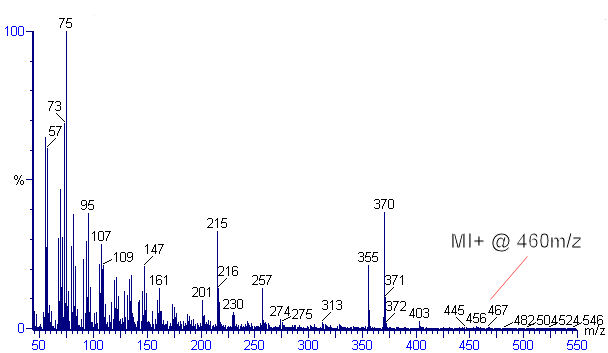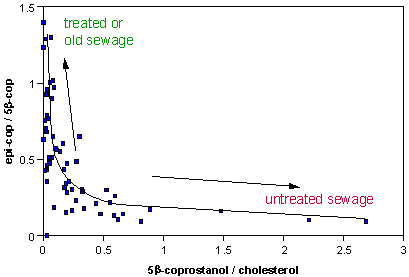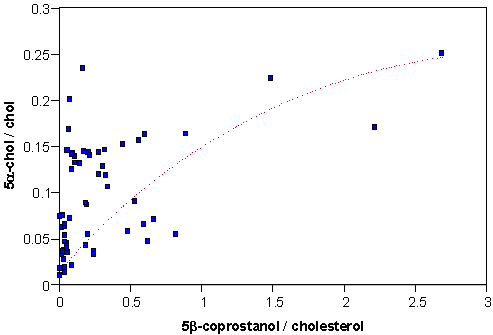
Coprostanol
Encyclopedia
5β-Coprostanol is a 27 carbon
stanol formed from the biohydrogenation of cholesterol
(cholest-5en-3β-ol) in the gut
of most higher animals and birds. This compound has frequently been used as a biomarker for the presence of human
faecal
matter in the environment
.
and consequently a high octanol – water partition coefficient
(log Kow = 8.82). This means that in most environmental systems, 5β-coprostanol will be associated with the solid phase.
sediments and soils, 5β-coprostanol is stable for many hundreds of years enabling it to be used as an indicator of past faecal discharges.
has a hydroxyl
(-OH) group, it is frequently bound to other lipids including fatty acids; most analytical methods, therefore, utilise a strong alkali
(KOH or NaOH) to saponify
the ester
linkages. Typical extraction solvents include 6% KOH in methanol
. The free sterols and stanols (saturated sterols) are then separated from the polar lipids by partitioning into a less polar solvent (e.g. hexane
). Prior to analysis, the hydroxyl group is frequently derivatised with BSTFA
(bis-trimethyl silyl trifluoroacetamide) to replace the hydrogen with the less exchangeable trimethylsilyl (TMS) group. Instrumental analysis is frequently conducted on gas chromatograph (GC) with either a flame ionisation detector (FID) or mass spectrometer (MS). The mass spectrum
for 5β-coprostanol - TMS ether can be seen in the figure.

intermediate can be seen in the figure proposed by Grimalt et al., 1990.

There are a small number of animals, however, that have been shown not to produce 5β-coprostanol and these can be seen in the table.
is around 2-6% of the dry solids. This relatively high concentration and its stability allows it to be used in the assessment of the faecal matter in samples, especially sediments.
gut
, the ratio of the product over reactant can be used to indicate the degree of faecal matter in samples. Raw untreated sewage typically has a 5β-coprostanol / cholesterol ratio of ~10 which decreases through a sewage treatment plant (STP) such that in the discharged liquid wastewaters the ratio is ~2. Undiluted STP wastewaters may be identified by this high ratio. As the faecal matter is dispersed in the environment, the ratio will decrease as more (non-faecal) cholesterol from animals is encountered. Grimalt & Albaiges have suggested that samples with a 5β-coprostanol / cholesterol greater than 0.2 may be considered as contaminated by faecal material.
s in the 5β form. 5α-cholestanol is formed naturally in the environment by bacteria and generally does not have a faecal origin. Samples with ratios greater than 0.7 may be contaminated with human faecal matter; samples with values less than 0.3 may be considered uncontaminated. Samples with ratios between these two cut-offs can not readily be categorised on the basis of this ratio alone.

Sediments falling in the red region are classed as “contaminated” by both of the two ratios and those in the green region are classified as “uncontaminated” by the same measures. Those in the blue region are “uncontaminated” according to the 5β-coprostanol / cholesterol ratio and “uncertain” in the 5β-coprostanol / (5β-coprostanol + 5α-cholestanol) ratio. The majority of the samples between the 0.3 and 0.7 cut-offs are considered as “uncontaminated” according to the 5β-coprostanol / cholesterol ratio and so the 0.3 value must be considered as somewhat conservative.


It may be suggested from this relationship that sewage discharges are in part responsible for the anaerobic reducing conditions in the sediments.
Carbon
Carbon is the chemical element with symbol C and atomic number 6. As a member of group 14 on the periodic table, it is nonmetallic and tetravalent—making four electrons available to form covalent chemical bonds...
stanol formed from the biohydrogenation of cholesterol
Cholesterol
Cholesterol is a complex isoprenoid. Specifically, it is a waxy steroid of fat that is produced in the liver or intestines. It is used to produce hormones and cell membranes and is transported in the blood plasma of all mammals. It is an essential structural component of mammalian cell membranes...
(cholest-5en-3β-ol) in the gut
Gut (zoology)
In zoology, the gut, also known as the alimentary canal or alimentary tract, is a tube by which bilaterian animals transfer food to the digestion organs. In large bilaterians the gut generally also has an exit, the anus, by which the animal disposes of solid wastes...
of most higher animals and birds. This compound has frequently been used as a biomarker for the presence of human
Human
Humans are the only living species in the Homo genus...
faecal
Feces
Feces, faeces, or fæces is a waste product from an animal's digestive tract expelled through the anus or cloaca during defecation.-Etymology:...
matter in the environment
Ecosystem
An ecosystem is a biological environment consisting of all the organisms living in a particular area, as well as all the nonliving , physical components of the environment with which the organisms interact, such as air, soil, water and sunlight....
.
Solubility
5β-coprostanol has a low water solubilitySolubility
Solubility is the property of a solid, liquid, or gaseous chemical substance called solute to dissolve in a solid, liquid, or gaseous solvent to form a homogeneous solution of the solute in the solvent. The solubility of a substance fundamentally depends on the used solvent as well as on...
and consequently a high octanol – water partition coefficient
Partition coefficient
In chemistry and the pharmaceutical sciences, a partition- or distribution coefficient is the ratio of concentrations of a compound in the two phases of a mixture of two immiscible solvents at equilibrium. The terms "gas/liquid partition coefficient" and "air/water partition coefficient" are...
(log Kow = 8.82). This means that in most environmental systems, 5β-coprostanol will be associated with the solid phase.
Degradation
In anaerobicHypoxia (environmental)
Hypoxia, or oxygen depletion, is a phenomenon that occurs in aquatic environments as dissolved oxygen becomes reduced in concentration to a point where it becomes detrimental to aquatic organisms living in the system...
sediments and soils, 5β-coprostanol is stable for many hundreds of years enabling it to be used as an indicator of past faecal discharges.
Chemical analysis
Since the moleculeMolecule
A molecule is an electrically neutral group of at least two atoms held together by covalent chemical bonds. Molecules are distinguished from ions by their electrical charge...
has a hydroxyl
Hydroxyl
A hydroxyl is a chemical group containing an oxygen atom covalently bonded with a hydrogen atom. In inorganic chemistry, the hydroxyl group is known as the hydroxide ion, and scientists and reference works generally use these different terms though they refer to the same chemical structure in...
(-OH) group, it is frequently bound to other lipids including fatty acids; most analytical methods, therefore, utilise a strong alkali
Alkali
In chemistry, an alkali is a basic, ionic salt of an alkali metal or alkaline earth metal element. Some authors also define an alkali as a base that dissolves in water. A solution of a soluble base has a pH greater than 7. The adjective alkaline is commonly used in English as a synonym for base,...
(KOH or NaOH) to saponify
Saponification
Saponification is a process that produces soap, usually from fats and lye. In technical terms, saponification involves base hydrolysis of triglycerides, which are esters of fatty acids, to form the sodium salt of a carboxylate. In addition to soap, such traditional saponification processes...
the ester
Ester
Esters are chemical compounds derived by reacting an oxoacid with a hydroxyl compound such as an alcohol or phenol. Esters are usually derived from an inorganic acid or organic acid in which at least one -OH group is replaced by an -O-alkyl group, and most commonly from carboxylic acids and...
linkages. Typical extraction solvents include 6% KOH in methanol
Methanol
Methanol, also known as methyl alcohol, wood alcohol, wood naphtha or wood spirits, is a chemical with the formula CH3OH . It is the simplest alcohol, and is a light, volatile, colorless, flammable liquid with a distinctive odor very similar to, but slightly sweeter than, ethanol...
. The free sterols and stanols (saturated sterols) are then separated from the polar lipids by partitioning into a less polar solvent (e.g. hexane
Hexane
Hexane is a hydrocarbon with the chemical formula C6H14; that is, an alkane with six carbon atoms.The term may refer to any of four other structural isomers with that formula, or to a mixture of them. In the IUPAC nomenclature, however, hexane is the unbranched isomer ; the other four structures...
). Prior to analysis, the hydroxyl group is frequently derivatised with BSTFA
BSTFA
N,O-Bistrifluoroacetamide is a chemical compound which is used to derivitise labile groups such as hydroxyl on other chemicals, with the more stable trimethylsilyl group, which protects the labile group and allows the compound to be used for analytical purposes or as a chemical reagent for...
(bis-trimethyl silyl trifluoroacetamide) to replace the hydrogen with the less exchangeable trimethylsilyl (TMS) group. Instrumental analysis is frequently conducted on gas chromatograph (GC) with either a flame ionisation detector (FID) or mass spectrometer (MS). The mass spectrum
Mass spectrum
A mass spectrum is an intensity vs. m/z plot representing a chemical analysis. Hence, the mass spectrum of a sample is a pattern representing the distribution of ions by mass in a sample. It is a histogram usually acquired using an instrument called a mass spectrometer...
for 5β-coprostanol - TMS ether can be seen in the figure.

Isomers
As well as the faecally derived stanol, two other isomers can be identified in the environment; 5α-cholestanol (5α-cholestan-3β-ol) and epi-coprostanol (5β-cholestan-3α-ol).Faecal sources
5β-coprostanol is formed by the conversion of cholesterol to coprostanol in the gut of most higher animals by intestinal bacteria. The general scheme for its production via a ketoneKetone
In organic chemistry, a ketone is an organic compound with the structure RCR', where R and R' can be a variety of atoms and groups of atoms. It features a carbonyl group bonded to two other carbon atoms. Many ketones are known and many are of great importance in industry and in biology...
intermediate can be seen in the figure proposed by Grimalt et al., 1990.

| Animals Producing Coprostanol | Animals NOT Producing Coprostanol |
|---|---|
| Humans | dogs |
| Cattle | ? |
| Sheep | ? |
| Birds | ? |
There are a small number of animals, however, that have been shown not to produce 5β-coprostanol and these can be seen in the table.
Use as a tracer for sewage
The principal source of 5β-coprostanol in the environment is from human wastes. The concentration of 5β-coprostanol in raw, untreated sewageSewage
Sewage is water-carried waste, in solution or suspension, that is intended to be removed from a community. Also known as wastewater, it is more than 99% water and is characterized by volume or rate of flow, physical condition, chemical constituents and the bacteriological organisms that it contains...
is around 2-6% of the dry solids. This relatively high concentration and its stability allows it to be used in the assessment of the faecal matter in samples, especially sediments.
5β-coprostanol / cholesterol ratio
Since 5β-coprostanol is formed from cholesterol in the vertebrateVertebrate
Vertebrates are animals that are members of the subphylum Vertebrata . Vertebrates are the largest group of chordates, with currently about 58,000 species described. Vertebrates include the jawless fishes, bony fishes, sharks and rays, amphibians, reptiles, mammals, and birds...
gut
Gut (zoology)
In zoology, the gut, also known as the alimentary canal or alimentary tract, is a tube by which bilaterian animals transfer food to the digestion organs. In large bilaterians the gut generally also has an exit, the anus, by which the animal disposes of solid wastes...
, the ratio of the product over reactant can be used to indicate the degree of faecal matter in samples. Raw untreated sewage typically has a 5β-coprostanol / cholesterol ratio of ~10 which decreases through a sewage treatment plant (STP) such that in the discharged liquid wastewaters the ratio is ~2. Undiluted STP wastewaters may be identified by this high ratio. As the faecal matter is dispersed in the environment, the ratio will decrease as more (non-faecal) cholesterol from animals is encountered. Grimalt & Albaiges have suggested that samples with a 5β-coprostanol / cholesterol greater than 0.2 may be considered as contaminated by faecal material.
5β-Coprostanol / (5β-Coprostanol + 5α-Cholestanol) Ratio
Another measure of human faecal contamination is the proportion of the two 3β-ol isomerIsomer
In chemistry, isomers are compounds with the same molecular formula but different structural formulas. Isomers do not necessarily share similar properties, unless they also have the same functional groups. There are many different classes of isomers, like stereoisomers, enantiomers, geometrical...
s in the 5β form. 5α-cholestanol is formed naturally in the environment by bacteria and generally does not have a faecal origin. Samples with ratios greater than 0.7 may be contaminated with human faecal matter; samples with values less than 0.3 may be considered uncontaminated. Samples with ratios between these two cut-offs can not readily be categorised on the basis of this ratio alone.

Sediments falling in the red region are classed as “contaminated” by both of the two ratios and those in the green region are classified as “uncontaminated” by the same measures. Those in the blue region are “uncontaminated” according to the 5β-coprostanol / cholesterol ratio and “uncertain” in the 5β-coprostanol / (5β-coprostanol + 5α-cholestanol) ratio. The majority of the samples between the 0.3 and 0.7 cut-offs are considered as “uncontaminated” according to the 5β-coprostanol / cholesterol ratio and so the 0.3 value must be considered as somewhat conservative.
5β-coprostanol / 24-ethyl coprostanol
Herbivores such as cows and sheep consume terrestrial plant matter (grass) which contains β-sitosterol as the principal sterol. β-sitosterol is the 24-ethyl derivative of cholesterol and can be used as a biomarker for terrestrial plant matter (see section). In the gut of these animals, bacteria biohydrogenate the double bond in the 5 position to create 24-ethyl coprostanol and so this compound can be used as a biomarker for faecal matter from herbivores. Typical values in different source materials can be seen in the table after Gilpin.| Source | 5β-cop / 24-ethyl cop |
|---|---|
| Septic tanks | 2.9 – 3.7 |
| Community wastewater | 2.6 – 4.1 |
| Abattoir – sheep, cattle | 0.5 – 0.9 |
| Dairy shed wash-down | 0.2 |
Epi-coprostanol / 5β-coprostanol
During sewage treatment, 5β-coprostanol may be converted to 5β-cholestan-3α-ol form, epi-coprostanol. There is also a slow conversion of 5β-coprostanol to epi-coprostanol in the environment and so this ratio will indicate either the degree of treatment of sewage or its age in the environment. A cross-plot of the 5β-coprostanol / cholesterol ratio with the epi-coprostanol / 5β-coprostanol can indicate both faecal contamination and treatment.
5α-cholestanol / cholesterol
In the environment, bacteria preferentially produce 5α-cholestan-3β-ol (5α-cholestanol) from cholesterol rather than the 5β isomer. This reaction occurs principally in anaerobic reducing sediments and the 5α-cholestanol / cholesterol ratio may be used as a secondary (process) biomarker for such conditions. No cut-off values have been suggested for this marker and so it is used in a relative sense; the greater the ratio, the more reducing the environment. Reducing environments are frequently associated with areas experiencing high organic matter input; this may include sewage derived discharges. The relationship between reducing conditions and the potential source can be seen in a cross plot with a sewage indicator.
It may be suggested from this relationship that sewage discharges are in part responsible for the anaerobic reducing conditions in the sediments.

